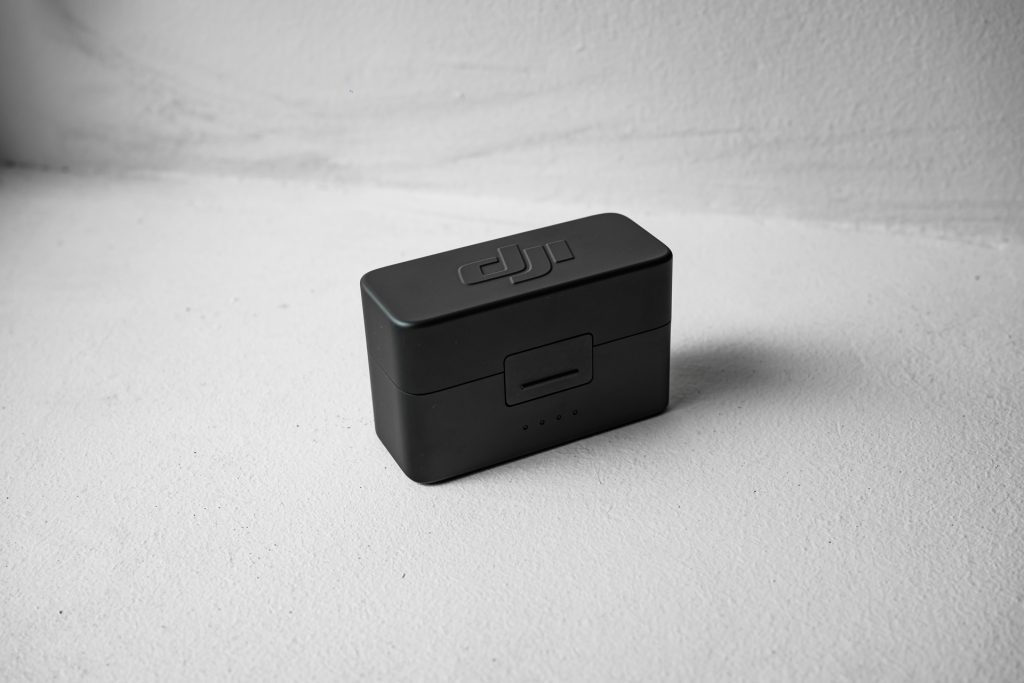The DJI Mic Mini has arrived with a promise: simple, effective, and portable audio recording without breaking the bank.
Following in the footsteps of the DJI Mic and Mic 2, this compact contender aims to be the go-to mic system for casual creators.
But does it hold its own against its pricier predecessors?
what’s it like?

First impressions matter, and the Mic Mini doesn’t disappoint… mostly. Like its big brother, the Mic 2, the Mic Mini comes neatly packed in a latched charging case.
This little pod houses two transmitters, a receiver, and windscreens, all snugly secured. The case itself is lightweight plastic compared to the Mic 2’s all-metal finish, signalling its budget-friendly nature. Yet, it feels surprisingly premium for its price.

Inside, you’ll find thoughtful extras: a soft carrying pouch, spare windscreens, a USB-A-to-USB-C cable, and a 3.5mm audio cable for wired setups. The windscreens can stay attached while docked in the case, an oddly satisfying detail for anyone who dreads reassembly mid-shoot.
But here’s where the cost-cutting starts to peek through. Unlike the Mic 2, the Mini transmitters lack internal recording, a safety net that’s sorely missed when signal interruptions strike. However, it makes up for this with “Auto Limiting,” a nifty feature that prevents audio clipping.

The receiver is similarly stripped down: gone are the touchscreen controls and 3.5mm headphone jack. Instead, you get a manual gain wheel, a cold shoe mount, and a USB-C adapter.
The compromise is simplicity. If you’re using DJI’s Mimo app or a DJI Osmo device, you can bypass the receiver entirely and connect via Bluetooth.
how easy is it to control?

Straightforward, if a little minimalist.
The transmitters feature dual-purpose buttons: power and link. Tap the link button, and you’re live, audio and video rolling via the DJI Mimo app. Noise-cancelling settings are also baked into the power button; a quick press toggles between strong and basic modes.
On the receiver, controls are equally fuss-free: power, link, and a gain wheel. But here’s the catch, you’ll need to monitor signal levels through the Mimo app, as the receiver lacks an input meter. Fortunately, Auto Limiting steps in to handle distortion worries, keeping your audio crisp and clean.
how does it perform?

The Mic Mini pairs seamlessly via USB-C, Bluetooth 5.3, or the trusty 3.5mm cable. Whether you’re using a DJI Osmo gimbal, your phone, or a DSLR, the setup is intuitive. And once connected, the difference is stark.
Of course, compared to a smartphone internal microphone, the difference was night and day. Voices came through loud, clear, and upfront, though a touch of room reverb lingered in quieter spaces.
When tested outdoors, the noise-cancelling feature isn’t perfect (it won’t mute loud sounds like a blaring siren) but it does a commendable job reducing low-end rumble. In a busy urban jungle, your voice cuts through the chaos.

DJI promises a 120-metre transmission range, but actual usage depends on your environment. In a bustling city, signal interruptions cropped up around the 60-metre mark.
And without internal recording as a backup, what you lose in transmission stays lost.
should you buy the DJI Mic Mini?

Overall, the DJI Mic Mini punches well above its weight, offering creators a budget-friendly option that delivers great audio without the bulk or complexity of pricier systems. It’s not without its compromises, but it knows its audience.
If you’re a casual content creator looking for an affordable, easy-to-use mic, this is a solid choice. It’s compact, reliable, and pairs beautifully with DJI’s Osmo lineup.
However, if your shoots are fast-paced, unpredictable, or high-stakes, you might miss the safety features of higher-end models like the DJI Mic 2. Internal recording and more robust receivers make those worth the extra investment.
Liked this? Check out more articles on Futr tech here.






